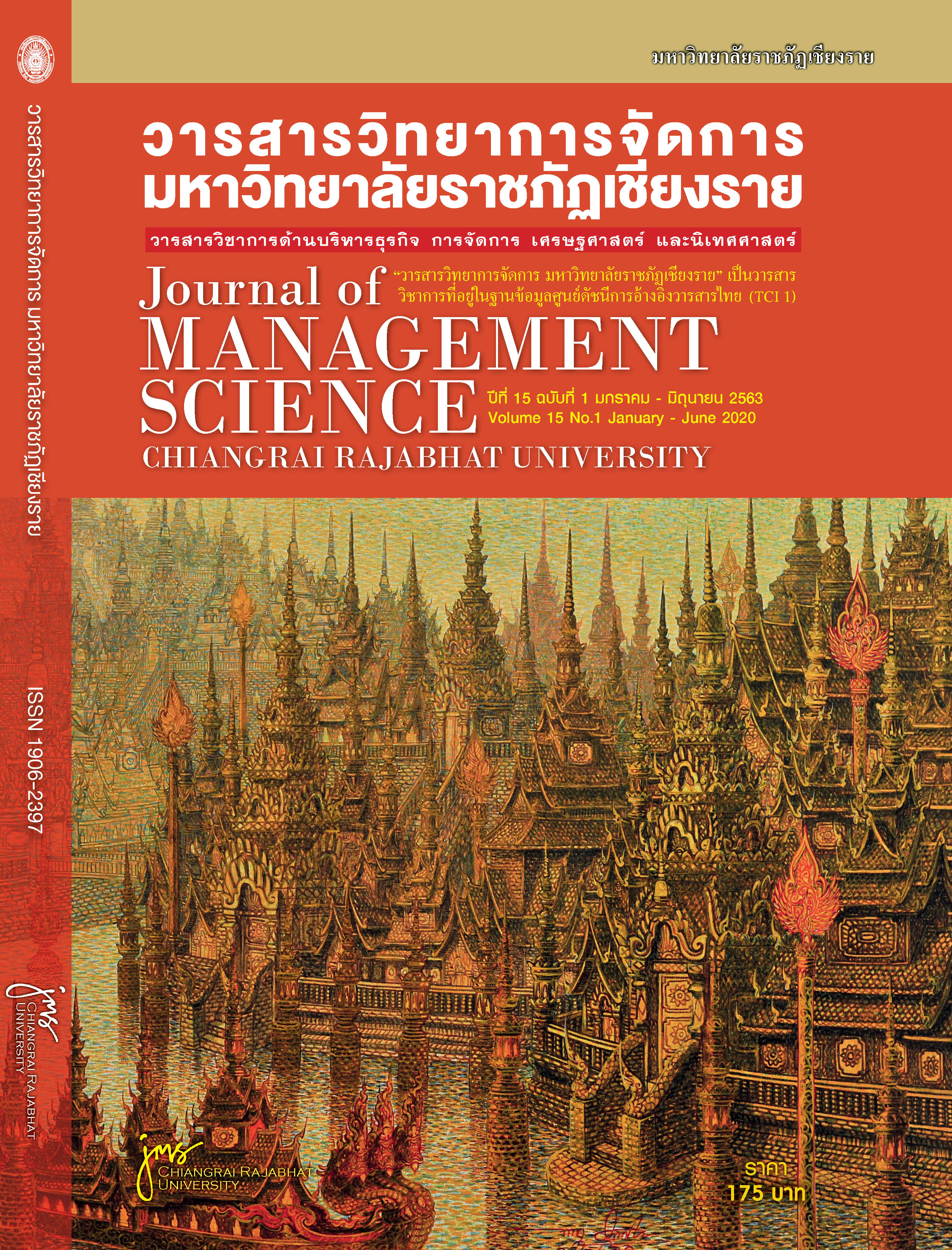Strategy Implementation to Organizational Competency Development in Tourist Accommodation in Thailand: An Exploratory Research with the McKinsey Seven S’s (7S’s) Approach
Main Article Content
Abstract
The strategic management has consecrated time to analyzing the concept of core competency of the firm in a particular approach as review on what are the abilities and skills that the firm possesses at the present may possess in to the future. In addition, it interested in how competencies that the firm possesses might be configured in order to achieve competitive advantages. The objectives of this study were as follows: (1) to identify the strategic implementation factors that can contribute to the perception of successful organizational competency development, and (2) to examine the factors that can contribute to the perception of successful organizational competency development leading to improved organizational performances with the McKinsey Seven S’s (7S’s) approach. A mixed-method research approach was used in this research. The sixteen businesses in four tourist destinations of Thailand were participated in semi-structured interview process as a qualitative phase. There were Chiang Mai, Bangkok, Pattaya, and Phuket. In quantitative phase (n = 375), to confirm the outcomes of the case study research a survey was developed and administered to over 1,050 participants in tourist accommodation in a whole Thailand. The key participants were hotel representative such as business owners, general manager, or management level position within the organization. To achieve these research objectives, the data coding and descriptive analysis were performed in qualitative phase while statistics and confirmatory factor analysis were adopted in quantitative phase.
Article Details
Views and opinions expressed in the journal do not necessarily reflect those of the editors.
References
Aldrich, H. E. (1979). Organizations and environments. Englewood Cliffs, NJ. Prentice-Hall.
Andrews, K. R. (1979). The concept of corporate Strategy. Richard D. Irwin, Homewood, IL.
Armstrong, M. (2010). Armstrong’s essential human resource management practice: A guide to people management. United states: Koyan Page.
Barney, J. B. (1991). Firm resources and sustained competitive advantage. Journal of Management. 17(1). 99-120.
Boyatzis, R. E. (1982). The competent manager: A model for effective performance. New York : Wiley.
Chareanporn, T. (2012). An assessment of front office attendant’s competency in hotel business. Master dissertation. Mahidol International College. Thailand
Dahlgaard-Park, S. M. & Dahlgaard, J. J. (2007). Excellence-25 years evolution. Journal of Management History. 13(4). 371 - 393.
Feurer, R. & Chaharbaghi, K. (1995). Strategy development: past, present and future. Management Decision. 33(6).
Grant, R. M. (1991). The resource-based theory of competitive advantage: implications for strategy formulation. California Management Review. 33(3). 114-36.
Hayton, J. C. & Kelley, D. J. (2006). A competency based framework for promoting corporate entrepreneurship. Human Resource Management. 45(3). 407-427.
Hollenbeck, G. P., McCall, M. W. & Silzer, R. F. (2006). Leadership competency models. The Leadership Quarterly. 17(4). 398-413.
Kasikornbank Public Company Limited. (2019). Thailand's tourism industry outlook 2019. Retrieved July 8, 2019, from https://www.kasikornbank.com/international business/en/Thailand/IndustryBusiness/Pages/201901_ Thailand_TourismOutlook19.aspx
Krungsri Research. (2018). Thailand quarterly industry review: Hotel Industry (Quarter3/2018). Retrieved July 8, 2019, from https://webcache.googleusercontent.com/search?q=cache:UCTTeT5LhxUJ: https://www.krungsri.com/bank/getmedia/73f44ed5-b06e-4a52-a0fd-5ca8e6a27ec5/QIR_Hotel_181218_ Q3_EN.aspx+&cd=3&hl=en&ct=clnk&gl=th
Kumsuprom. S. (2010). Structured approach to organisational ICT risk management: An empirical study in Thai businesses. (Doctoral dissertation). School of Business Information Technology and Logistics Business Portfolio, RMIT University, Australia.
Ljungquist, U. (2007). Core competency beyond identification: presentation of a model. Management Decision. 45(3). 393-402.
Lin, C., Tsai, H. L. & Wu, J. C. (2014). Collaboration strategy decision-making using the Miles and Snow typology. Journal of Business Research. 67(9). 1979-1990.
Miles, R. E. & Snow, C. C. (1978). Organizational strategy, structure and process. New York : MacGraw Hill.
Mingmalairaks, P., Kumsuprom, S., Jongsureyapart, C., Kamwass, S. & Tiangsoongnern, L. (2016). Value creation and core competency enhancement with technology and innovation adoption in Thai medium sized companies: A case study of the car materials industry, the 4th GARCOMBS 2016, 7-9th October 2016, IAE CAEN Campus, France.
Mintzberg, H. (1979). Patterns in strategy formation. International Studies of Management & Organization. 9(3). 67-86.
Mitaree, R. (2006). An evaluation of a competency model developed and implemented for excecutives at a Thai services business state enterprise. (Master thesis). Ramkhamhaeng. Thailand.
Mitchelmore, S. & Rowley, J. (2010). Entrepreneurial competencies: a literature review and development agenda, International Journal of Entrepreneurial Behavior & Research. 16(2). 92-111.
Murray, P. (2003). Organisational learning, competencies and firm performance: empirical observations. The Learning Organization. 10(5). 305-16.
The Nation Thailand (2019). 2019 expected to be strong year for hotel investment. Retrieved February 19, 2019, from https://www.nationthailand.com/Real_Estate/30364399
Neuman, W. L. (2006). Social research methods: Qualitative and Quantitative Approaches. Boston : Pearson Education.
Parnell A. J. (2010). Strategic clarity, business strategy and performance. Journal of Strategy and Management. 3(4). 304-324.
Pascale, R. T. & Athos, A. G. (1981). The art of japanese management. New York : Simon & Schuster.
Perters, T. J. & Waterman, R. H. (2004). In search of excellence-lessons from America’s best-run companies. London : HarperCollins Publishers.
Prahalad, CK. & Hamel, G. (1990). The core competence of the corporation. Harvard Business Review. 198. 79-90.
Stalk, G., Evans, P. & Shulman, LE. (1992). Competing on capabilities: The new rules of Corporate Strategies. Harvard Business Review. 1992(March–April). 57 - 68.
Stokes, P. & Oiry, E. (2012). An evaluation of the use of competencies in human resource development – a historical and contemporary recontextualisation. EuroMed Journal of Business. 7(1). 4-23.
Taylor, CT. (2004). The development of core competence through emerging technology innovation: An empirical investigation. (Doctoral dissertation). Rensselaer Polytechnic Institute, USA.
Teh, D. & Corbitt, B. (2015). Building sustainability strategy in business. Journal of Business Strategy. 36(6). 39-46.


